Visiting a museum is exciting, and now, museums are bringing that experience online. A good museum website can show art, history, and culture in a simple and engaging way for everyone.
Did you know? In 2025, museums with SEO-friendly website structures saw up to 35% higher organic traffic.
In 2025, museum websites are focusing on easy navigation, clear design, and beautiful visuals. Features like virtual tours, mobile-friendly pages, and interactive galleries help visitors enjoy and explore collections from anywhere.
In this blog, we will share the top museum website designs that are setting trends in 2025. These websites show how museums can create an enjoyable online experience, attract more visitors, and present their collections in a modern and inspiring way.
Why Museum Website Design Matters in 2025
Museum website design plays a crucial role in attracting and retaining online visitors. Today, a museum’s website often serves as the first touchpoint for audiences worldwide. A poor online experience can discourage potential visitors, while a well-structured and visually appealing website can inspire curiosity and encourage exploration.
Modern museum websites act as a digital extension of the institution, combining aesthetics with usability. They help museums reach international audiences, provide virtual educational content, and allow users to engage with collections in interactive ways. According to recent studies, over 60% of museum-goers check a museum’s website before planning a visit, making online presentation more important than ever.
By prioritizing user experience, responsive design, and visual storytelling, museums can ensure that their website complements the physical experience and makes art, history, and culture accessible to everyone.
Museum Web Design Trends in 2025
Museum web design trends in 2025 focus on creating memorable, immersive digital experiences. Websites are no longer static catalogs but interactive platforms that engage users and tell compelling stories. Key trends include:
- Minimalist layouts with bold visuals: Museums are using clean, simple designs to let artwork and exhibits shine. Minimalism enhances readability and keeps visitors focused on content.
- Dark mode and cinematic designs: Especially popular among contemporary art museums, dark-themed websites provide a more immersive, gallery-like feel.
- Interactive storytelling: Features such as timelines, multimedia content, and scroll-triggered animations allow users to explore history and art in a narrative format.
- Personalized experiences: AI-driven recommendations suggest exhibits and collections based on visitor interests, increasing engagement.
- Mobile-first design: With increasing traffic from smartphones and tablets, mobile-responsive layouts are essential for modern museum websites.
- Virtual and augmented reality integrations: Museums are using VR and AR to simulate gallery tours, allowing users to explore remotely.
Museum Website UX Design: Creating an Engaging Experience
Museum website UX design is critical for ensuring visitors have an enjoyable and intuitive online experience. A good UX design makes information accessible, navigation seamless, and interactions satisfying, helping museums significantly improve website UI/UX.
Key principles include:
- Clear navigation: Menus should be logical, with sections for exhibitions, events, tickets, and collections.
- Search functionality: Users should find specific artworks or events easily.
- Interactive elements: Quizzes, virtual tours, and timelines engage users and encourage exploration.
- Accessibility: Websites should cater to all users, including those with disabilities, by providing alt texts, keyboard navigation, and readable fonts.
- Fast loading speed: Optimized images and clean code prevent slow-loading pages, improving retention and supporting an SEO-friendly website structure.
Importance of Museum Website Visuals
Visual appeal is at the heart of any museum website. Museum website visuals include high-resolution images, videos, and interactive galleries that showcase collections effectively.
Strong visuals not only highlight artwork but also convey the museum’s identity. For instance, contemporary art museums often employ bold, dynamic visuals to reflect creativity, while historical museums emphasize detailed imagery and storytelling elements. Interactive features, such as 360-degree views of galleries or zoomable images, enhance user engagement.
Balanced visuals also contribute to faster loading times and better usability. By combining aesthetics with functionality, museums can create a website that captivates visitors and encourages them to explore both online and offline.
Want a Modern Museum Website Upgrade?
We create clean, engaging, and interactive museum websites that improve user experience and attract more global visitors!
Top Museum Website Designs 2025: Inspiration
Here are the top museum website designs shaping trends in 2025:
1. The Louvre, Paris
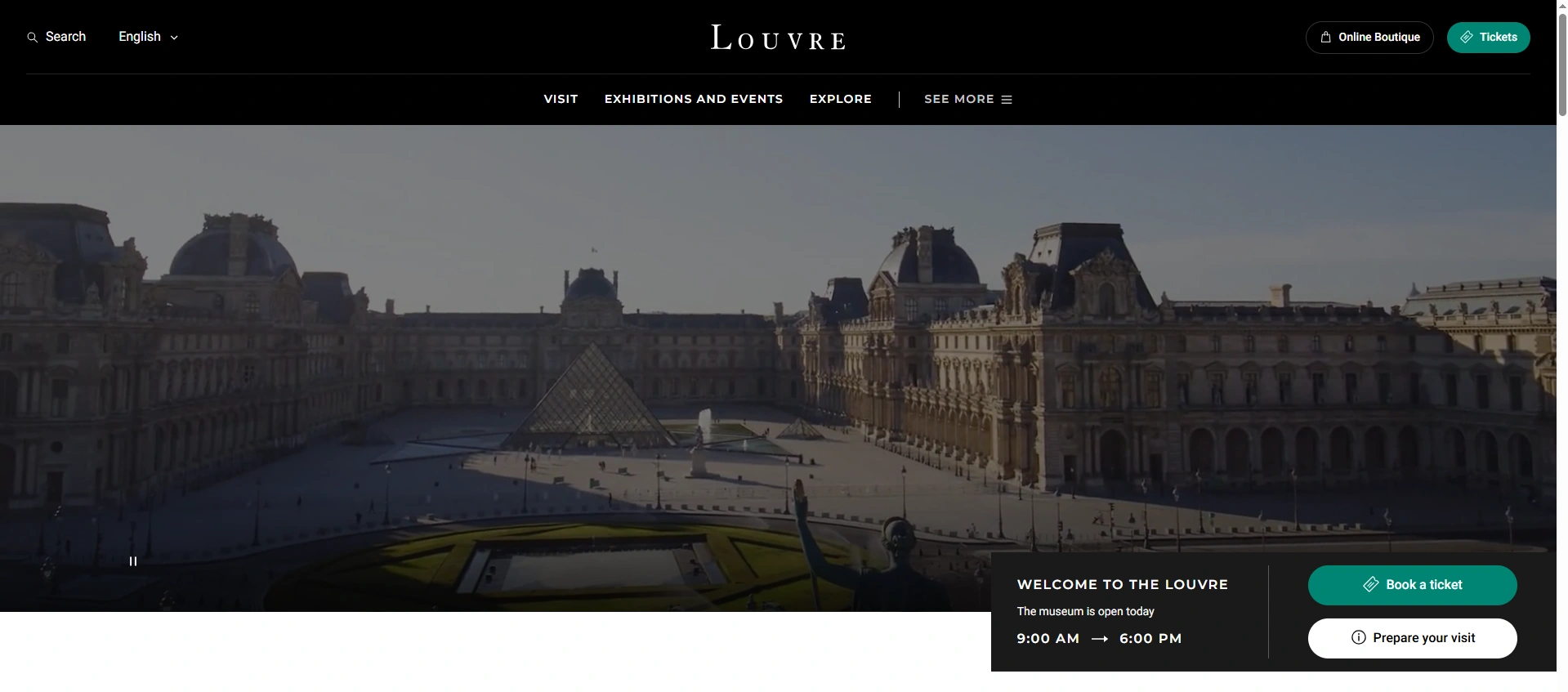
The Louvre’s website is a benchmark for museum website UX design, offering immersive high-resolution visuals of its world-famous collections. Visitors can explore exhibits through an interactive gallery that categorizes artwork by artist, era, or theme. The virtual tour replicates the feeling of walking through the museum, while educational resources and event highlights provide value for students, researchers, and casual visitors. Its mobile-responsive layout ensures smooth navigation across devices. The combination of elegant visuals, clear menus, and interactive elements makes the Louvre’s site a prime example of modern digital museum experience.
2. The British Museum, London
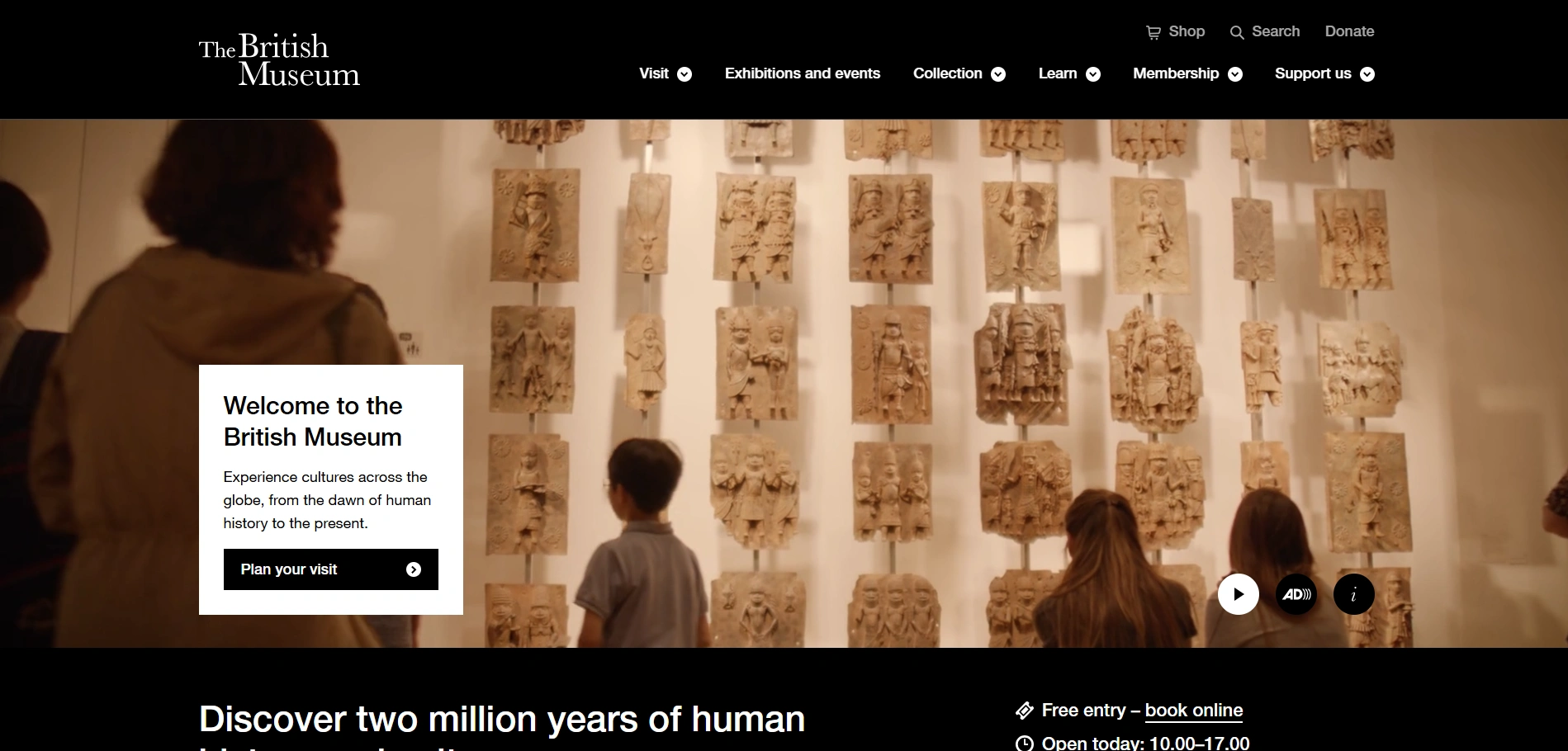
A perfect example of museum website UI/UX inspiration, the British Museum’s website emphasizes usability and accessibility. Its clean design allows visitors to navigate exhibitions, collections, and online events effortlessly. Virtual tours and zoomable artifact images create an interactive experience, while intuitive search tools help users locate specific collections quickly. The website also integrates educational content and detailed exhibition guides, making it ideal for learners and art enthusiasts worldwide. Its fast loading times and mobile optimization further reflect 2025 design trends.
3. MoMA, New York
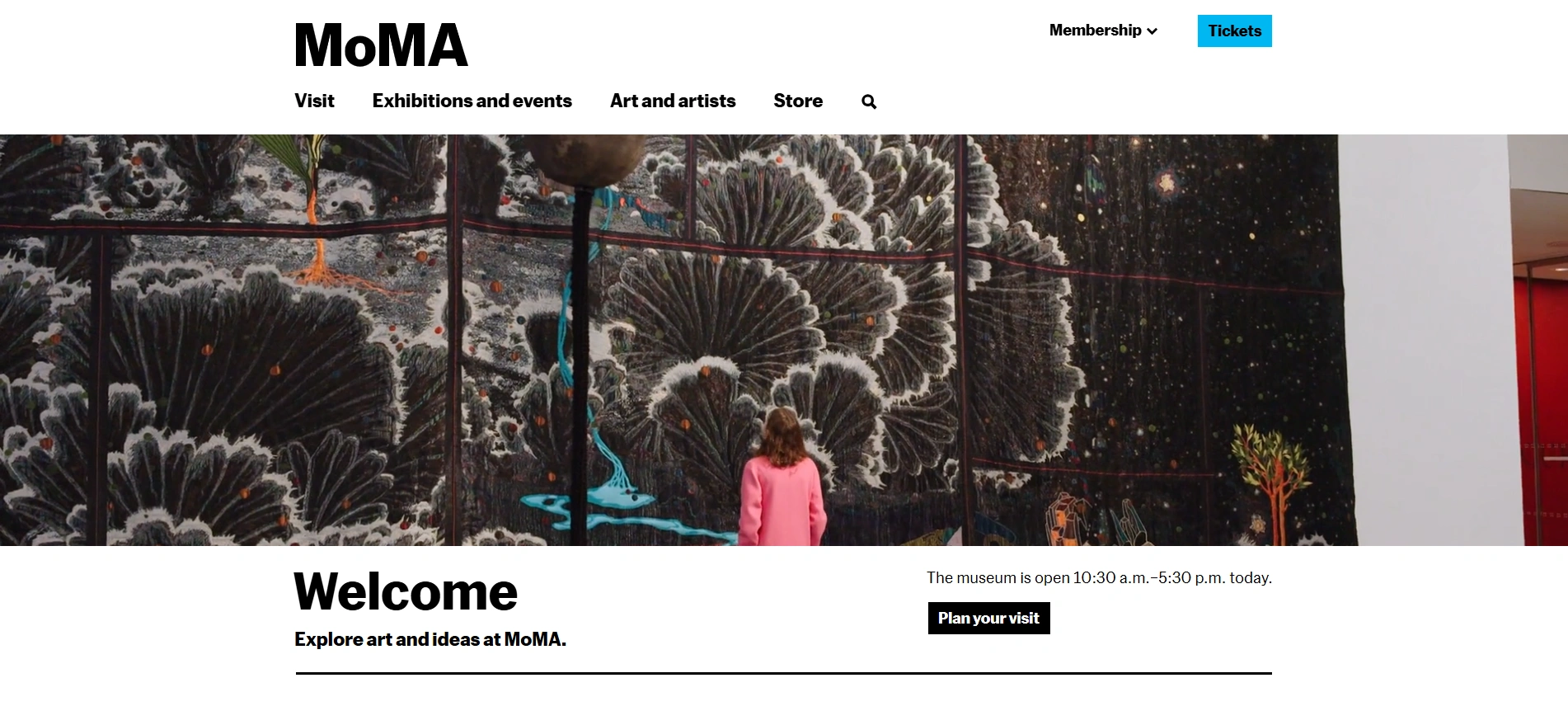
MoMA demonstrates modern museum website layouts with a focus on contemporary art and bold visuals. The homepage features curated collections and interactive highlights that engage visitors immediately. High-quality images and animations complement minimalistic typography, ensuring clarity while maintaining a creative aesthetic. MoMA’s website also includes virtual tours, event schedules, and online educational programs. The responsive design guarantees a seamless experience on all devices, making it an excellent case for museums aiming to combine modern aesthetics with functionality.
4. Rijksmuseum, Amsterdam
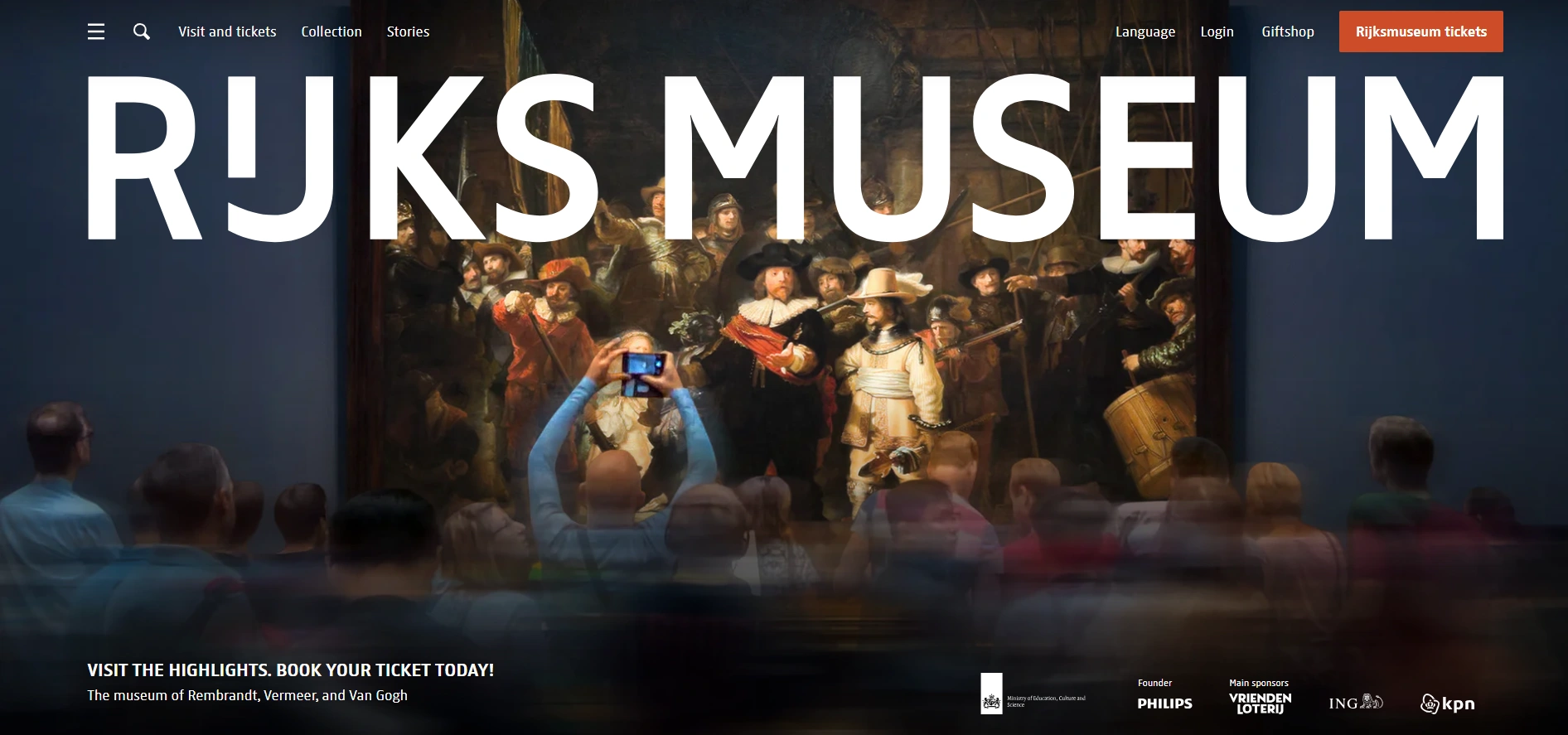
The Rijksmuseum showcases creative museum website design ideas, combining storytelling with interactive galleries. Users can explore collections using thematic tours, interactive timelines, and detailed artwork descriptions. The site integrates multimedia elements, including videos and animated graphics, to enrich the visitor’s understanding of historical contexts. Educational features such as quizzes and curated exhibitions enhance engagement for younger audiences and learners. Its clean layout, intuitive navigation, and mobile responsiveness make it a top example of 2025 museum web design trends.
5. National Gallery, London

The National Gallery uses museum website design examples that emphasize high-quality visuals and structured layouts. Its homepage features rotating highlights from the collection and showcases current exhibitions in an organized format. Virtual tours, detailed artwork pages, and contextual information make it easier for users to explore and learn. The site is mobile-friendly, accessible, and includes interactive guides for different age groups. This approach ensures that visitors can enjoy the museum experience both online and offline.
6. Guggenheim Museum, New York

The Guggenheim’s website is an example of interactive museum websites, focusing on engagement through dynamic content. Its homepage features video tours, interactive exhibition previews, and animated galleries. The use of motion graphics and creative layout design reflects the museum’s contemporary art focus. Users can explore collections by artist, medium, or thematic category, and events are highlighted with clear CTAs for ticket bookings. Its mobile-first design and responsive interface make it a perfect example for museums aiming to blend creativity and usability.
7. Tate Modern, London

Tate Modern integrates multimedia content, animations, and interactive features to enhance user engagement. High-resolution images, video interviews with artists, and event highlights create a comprehensive digital experience. The site uses intuitive navigation, allowing visitors to filter collections, exhibitions, and resources efficiently. Accessibility features and mobile responsiveness ensure that the website is inclusive for all users. Tate Modern demonstrates how museums can combine storytelling, visuals, and functionality for a truly immersive digital presence.
8. Smithsonian National Museum, Washington D.C.

A standout responsive museum website design, the Smithsonian’s site prioritizes usability across devices. Its layout features clear menus, interactive collections, and educational resources for learners of all ages. Users can access virtual tours, 3D artifact views, and event calendars with ease. The website also incorporates social sharing options and multimedia content, reflecting modern digital experience design principles. The combination of accessibility, performance, and engaging content makes it a model for museums worldwide.
9. Van Gogh Museum, Amsterdam

The Van Gogh Museum excels in creative visual storytelling. The website uses immersive imagery, dynamic layouts, and multimedia content to highlight the artist’s works and life. Virtual exhibitions allow users to explore paintings in detail, while interactive timelines provide historical context. The homepage is visually appealing and guides visitors through collections effortlessly. Educational features, such as curated tours for students, enhance engagement. Its responsive and accessible design ensures a seamless experience across devices, inspiring museum web design worldwide.
10. Uffizi Gallery, Florence

The Uffizi Gallery balances elegance and usability with its website design. Visitors can explore Renaissance collections via structured navigation and detailed descriptions of artwork. Interactive galleries allow users to zoom in on masterpieces, while multimedia elements enrich the learning experience. The homepage highlights current exhibitions and events with visually appealing banners. Its mobile-responsive design ensures accessibility, and the minimalistic layout keeps the focus on art, making it a model for modern museum website layouts.
11. Pergamon Museum, Berlin

The Pergamon Museum focuses on interactive exhibits and digital guides, reflecting museum website design trends 2025. Its site allows users to virtually explore collections with interactive maps, 3D models, and detailed annotations. Educational content is integrated seamlessly, including videos, timelines, and explanatory texts. Clear navigation, responsive layouts, and accessibility features ensure a smooth online experience. The Pergamon Museum demonstrates how interactivity and storytelling can transform museum websites into engaging platforms for learning.
12. Musée d’Orsay, Paris
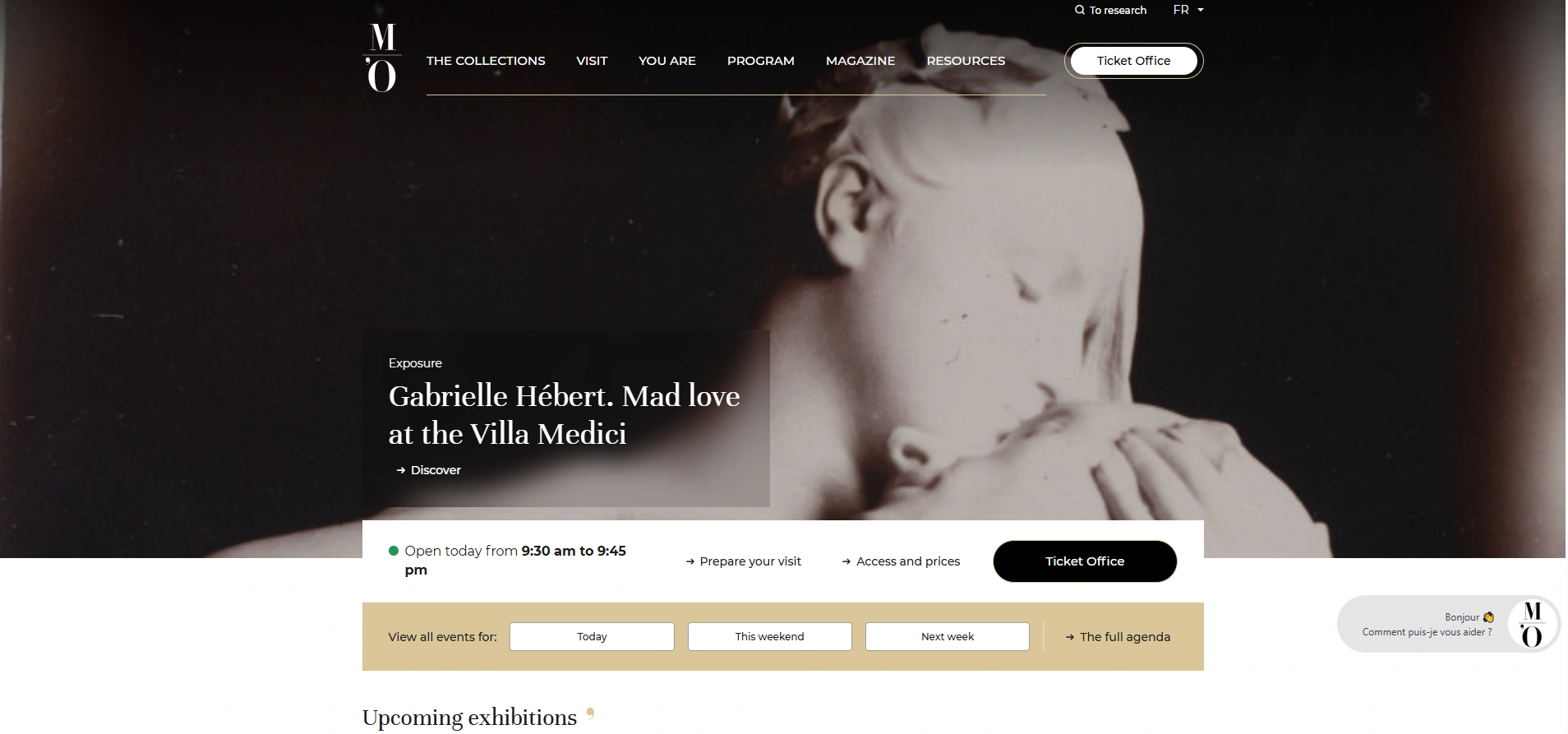
Musée d’Orsay’s website emphasizes beautiful visuals and user-friendly navigation. Large images, curated exhibitions, and virtual tours create an immersive experience. Educational resources, multimedia content, and interactive guides enhance engagement for students and art lovers. The website is mobile-friendly, loads quickly, and provides clear CTAs for ticket purchases and event participation. Its combination of aesthetics, UX, and accessibility makes it a strong example of contemporary museum website design.
13. J. Paul Getty Museum, Los Angeles

The Getty Museum combines intuitive layouts with immersive visuals to enhance the visitor journey online. Users can explore collections via curated exhibitions, interactive timelines, and zoomable images. The website also offers educational resources, event highlights, and multimedia storytelling features. Its responsive design ensures smooth performance across devices, and accessibility tools make the site usable for diverse audiences. The Getty Museum’s approach demonstrates how museums can balance creativity with usability in 2025.
14. Art Institute of Chicago

The Art Institute of Chicago’s website focuses on interactive digital experiences, offering virtual tours, online workshops, and multimedia guides. Navigation is clear, with collections, events, and educational resources easily accessible. High-resolution images, videos, and animations engage visitors, while responsive design ensures mobile accessibility. The website demonstrates how museums can create dynamic online platforms that replicate the richness of the physical museum experience.
15. National Museum of Korea, Seoul
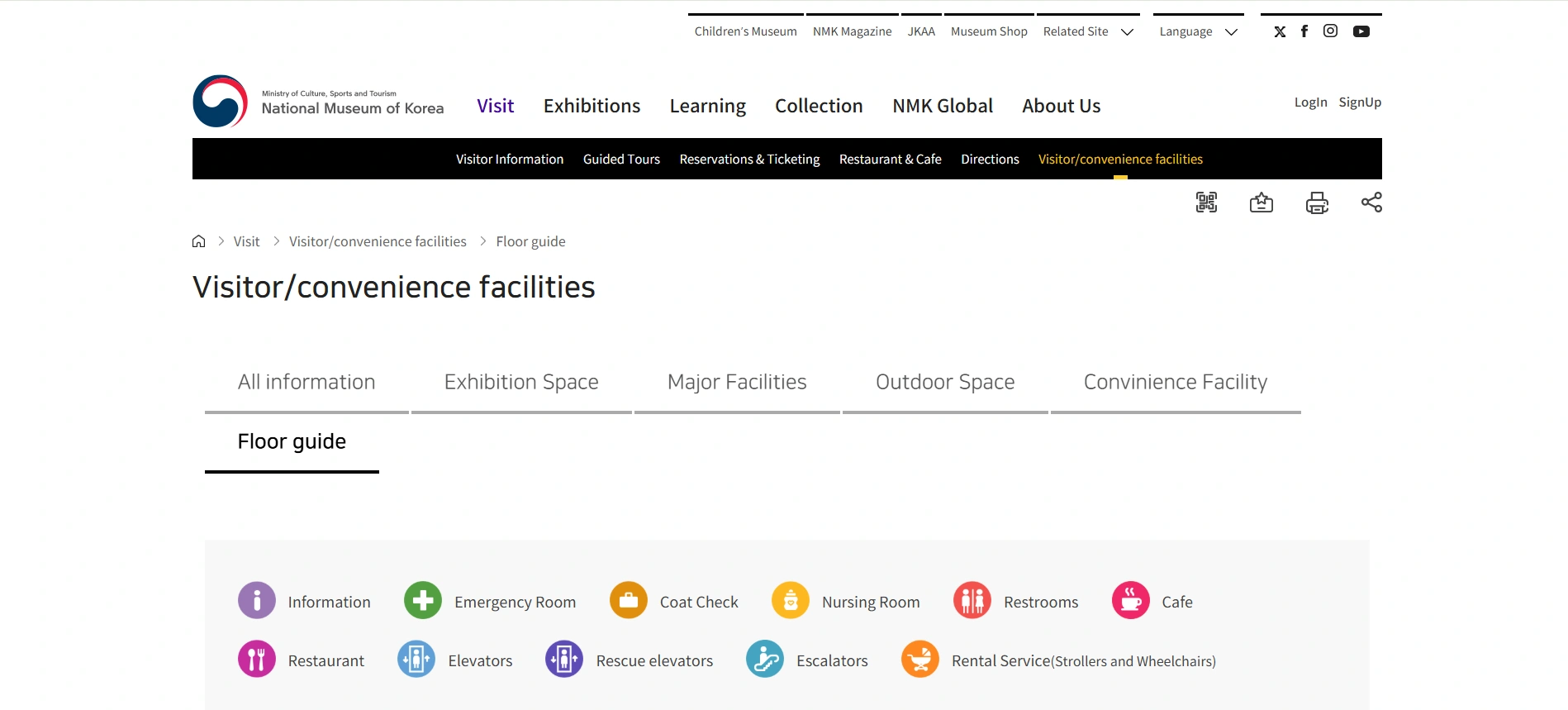
The National Museum of Korea showcases culture with a modern, digital-first approach. Its website includes interactive galleries, VR tours, and multimedia storytelling to educate and engage visitors. The homepage features visually striking banners, while intuitive navigation allows users to explore exhibitions, collections, and events seamlessly. Accessibility, fast loading times, and mobile responsiveness make it a model for global museum website design. It reflects modern trends and provides practical museum website design tips for other institutions.
Features of Modern Museum Digital Experience Design
A successful museum digital experience design goes far beyond just aesthetics. Modern museum websites are now immersive platforms that educate, entertain, and engage visitors in ways that were once possible only in physical spaces. Key features include:
1. Virtual Reality (VR) Tours
VR tours simulate walking through museum galleries, offering users an experience that feels close to being there in person. In 2025, museums like the Guggenheim and the British Museum are using VR to recreate galleries, enabling users to explore art and artifacts from anywhere in the world. These tours often include interactive hotspots, allowing visitors to click on an artwork for detailed information, enhancing engagement and learning. VR also helps museums reach global audiences who cannot visit physically, making cultural content accessible to everyone.
2. Augmented Reality (AR) Features
AR allows museums to overlay digital information on real-world exhibits. For example, users can point their mobile device at a piece of art to see additional multimedia content, animations, or historical context. This creates an interactive and educational experience that makes art and history more tangible. AR also supports gamified learning experiences, which can attract younger audiences and keep them engaged longer.
3. Multimedia Storytelling
Modern museum websites leverage videos, audio guides, and animations to tell stories about collections and exhibitions. The Rijksmuseum, for instance, uses video narratives to explain historical contexts of its artifacts. Multimedia storytelling allows museums to communicate complex information in an engaging, digestible way, enhancing visitor understanding and retention.
4. Social Media Integration
Sharing exhibits, events, and collections on social media helps museums connect with global audiences. Interactive social features, like embedded Instagram galleries or shareable content from exhibitions, encourage visitors to engage online and attract new visitors to the museum.
5. Personalized Recommendations
Many museums now offer AI-powered suggestions for users based on their browsing behavior or past interests. For example, a visitor exploring Renaissance art may receive recommended collections or virtual tours tailored to their preferences. This personalized approach keeps users engaged and encourages deeper exploration of the museum’s offerings.
Practical Tips for Museum Website Design
Creating an effective museum website in 2025 requires careful attention to UX, visuals, and accessibility, which is why many institutions prefer to hire web designer specialists instead of relying on generic templates. Here’s how museums can ensure their websites provide a modern, user-friendly experience:
1. Ensure Responsive Design
Websites must adapt to desktops, tablets, and smartphones. A responsive layout ensures smooth navigation, fast loading times, and clear visuals across devices. For example, the Van Gogh Museum optimizes images and interactive elements for mobile users, providing the same rich experience as on a desktop. Responsive design increases accessibility, reduces bounce rates, and is a core principle of modern museum website UX design.
2. Use High-Quality Visuals Without Slowing Load Times
Art and artifacts must be showcased in high-resolution, but large images can slow down websites. Optimizing visuals using compression tools ensures fast loading while maintaining quality. The Louvre’s website, for instance, balances stunning imagery with fast performance, keeping users engaged without frustration.
3. Include Interactive Features
Features like VR tours, AR experiences, quizzes, and gamified content create immersive engagement. Interactive elements encourage visitors to explore more content and increase time spent on the website. Museums like MoMA and Tate Modern successfully integrate these features, creating a memorable digital visit.
4. Focus on Intuitive Navigation and Logical Menu Structure
Clear, well-organized menus guide visitors to exhibitions, collections, events, and educational content effortlessly. Logical grouping, drop-downs, and search functionality improve usability, helping visitors find information quickly.
5. Highlight Exhibitions, Events, and Collections Prominently
Use banners, featured sections, and dynamic carousels to showcase current exhibitions and special events. This draws attention to important content and encourages ticket bookings or participation in virtual tours.
6. Make Websites Accessible
Websites should be inclusive for all users, including those with disabilities. Features such as alt text for images, keyboard navigation, readable fonts, and adjustable contrast make the site usable for a wider audience, aligning with global accessibility standards.
7. Regularly Update Content
A museum’s website should reflect new collections, events, and news. Frequent updates demonstrate an active, engaging institution and keep visitors returning for fresh experiences.
8. Integrate Social Sharing and Multimedia Content
Encourage visitors to share their favorite exhibits or experiences via social media. Embedding videos, podcasts, and interactive galleries adds richness to the website, providing multiple ways for users to engage with content.
How Mandy Web Design Helps Museums Build Modern, Engaging Digital Experiences
Mandy Web Design has earned a reputation as the best web designing company for museums and cultural institutions, standing out even among the top web design companies globally. With deep experience in custom website design, we understand how to translate a museum’s identity, collections, and stories into an engaging online experience that feels immersive and memorable.
Our team of top web designers focuses on creating museum websites that combine stunning visuals with advanced interactive features such as virtual tours, multimedia storytelling, AR elements, and well-structured digital galleries.
We offer affordable and transparent SEO web design packages tailored for museums of all sizes. Our pricing starts at just Rs. 13,000, ensuring that even small or emerging museums can access high-quality design without stretching their budget. With our transparent pricing, museums clearly understand their web design cost before starting the project.
Need Experts for Museum Website Design?
Our web designers build immersive, fast, and visually rich museum websites with modern features to enhance engagement and user satisfaction!
FAQs About Museum Website Design
A good museum website design focuses on simple navigation, high-quality visuals, fast loading speed, and interactive features like virtual tours. It should highlight collections clearly, offer accessible content, and provide an enjoyable digital experience for visitors across all devices.
Museums need a strong online presence to reach global audiences, promote exhibitions, offer educational content, and provide virtual experiences. A well-designed website helps attract more visitors, improves engagement, boosts cultural visibility, and supports digital transformation in today’s technology-driven world.
Modern museum websites should include virtual tours, multimedia storytelling, responsive design, clear navigation, online ticket booking, event highlights, and educational resources. These features create immersive digital experiences, help visitors explore collections easily, and ensure accessibility across all platforms.
Good UX improves museum websites by making them easy to use, visually appealing, and accessible. It enhances visitor interaction, increases engagement, simplifies navigation, and ensures users can explore collections or exhibits smoothly without confusion, frustration, or slow loading issues.
Visuals are essential because they present museum collections clearly, attract visitor attention, and create emotional impact. High-quality images, videos, and animations help museums tell stories effectively, improve user engagement, and make online exploration more enjoyable for audiences worldwide.
Museum websites use virtual tours to let visitors explore galleries digitally. These tours recreate real spaces, offer interactive hotspots, and provide detailed information about artworks. Virtual tours increase accessibility, attract global audiences, and enhance the museum’s overall digital experience.
The latest museum website design trends include immersive visuals, VR experiences, interactive galleries, bold layouts, clean typography, fast mobile performance, and AI-driven personalization. These trends help museums engage modern audiences and create rich digital journeys that reflect their brand identity.
Museums can improve mobile experience by using responsive layouts, optimizing images, simplifying menus, and adding mobile-friendly interactive features. Fast loading speed, clear buttons, and easy navigation ensure visitors enjoy exploring exhibits comfortably on smartphones and tablets.
Regular updates keep museum websites fresh, accurate, and engaging. Updating exhibitions, events, educational resources, and visuals maintains visitor interest, boosts SEO performance, and ensures the website reflects the museum’s current activities and cultural offerings.
Mandy Web Design helps museums by creating modern, visually rich, interactive, and mobile-friendly websites. We offer affordable packages, custom layouts, SEO-optimized designs, and smooth user experiences that highlight collections and enhance digital engagement for visitors globally.

About the Writer
Abhishek Thakur
Sr. Content Writer at Mandy Web Design
Abhishek Thakur is the Senior Content Writer at Mandy Web Design, where he crafts engaging content for the company’s website, blog, and marketing campaigns. With 5+ years of experience in digital marketing and SEO content creation, he specializes in turning complex topics into easy-to-understand, actionable strategies that help businesses grow online. He is passionate about creating high-quality, value-driven content that connects with audiences and builds brand authority. When he’s not writing, he enjoys exploring new ideas, learning the latest marketing trends, and improving his creative skills.



